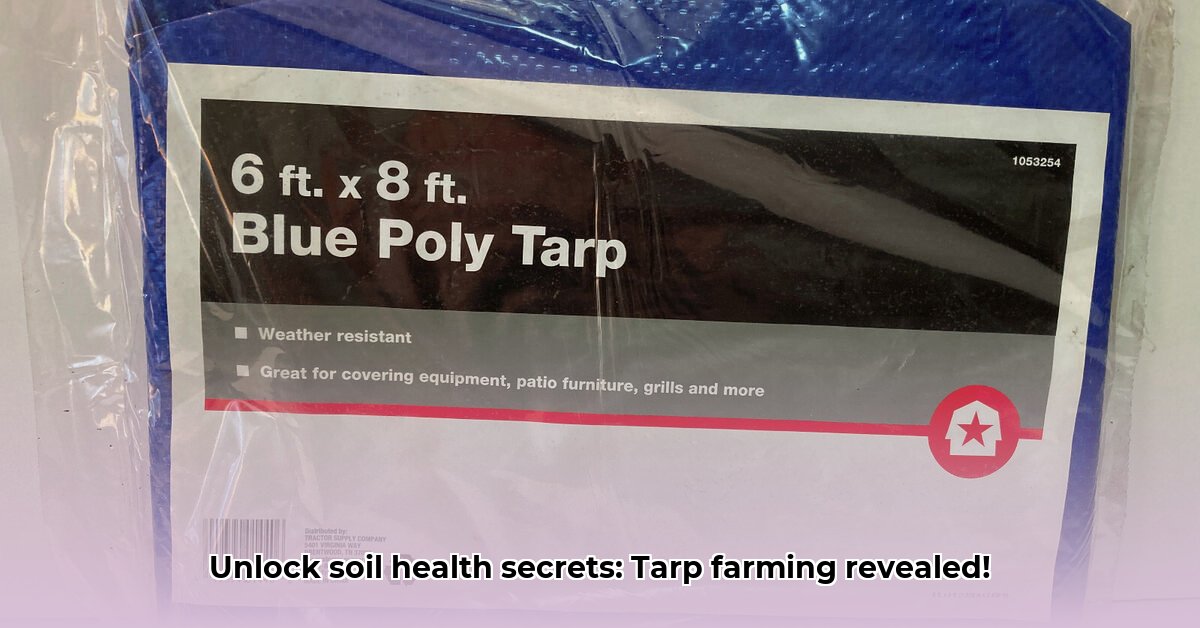
Tarps at Tractor Supply: Boosting Soil Health in Sustainable Agriculture
Sustainable agriculture hinges on effective resource management, and surprisingly, a simple tarp can play a significant role. This guide explores how tarps, readily available at Tractor Supply and similar retailers, contribute to sustainable farming practices, improving soil health, water management, and pest control. We'll examine various applications, helping you choose the right tarp for your specific needs. For boosting plant growth, consider supplementing with liquid fertilizers.
Tarps for Soil Health: Optimizing Soil Conditions
Healthy soil is the cornerstone of sustainable farming. Tarps offer several ways to enhance soil health, minimizing erosion, improving nutrient content, and suppressing weeds.
Cover Cropping: Protecting Young Plants
Cover crops are crucial for soil health, but young seedlings are vulnerable. A sturdy tarp acts as a protective shield, safeguarding them from harsh weather and pests until they are established. Heavier tarps (6-12 oz), with good UV resistance, provide the best protection. "Choosing the right tarp weight is paramount for successful cover cropping," says Dr. Emily Carter, Soil Scientist at the University of California, Davis. "A lighter tarp might offer adequate protection in mild climates, but a heavier one is essential in areas with harsh weather conditions."
Composting: Accelerating Decomposition
Composting accelerates the natural breakdown of organic matter, creating nutrient-rich soil amendments. A breathable tarp placed over your compost pile traps heat and moisture, speeding up the decomposition process. However, ensure adequate airflow to prevent anaerobic conditions that hinder decomposition and produce unpleasant odors. A woven polypropylene tarp with grommets for secure fastening is ideal. "A well-managed compost pile can significantly reduce the need for chemical fertilizers," notes Dr. John Miller, Extension Specialist in Sustainable Agriculture, Penn State University.
Erosion Control: Preventing Topsoil Loss
Soil erosion, the loss of valuable topsoil due to wind and water, significantly reduces soil fertility and productivity. Heavy-duty tarps (12-18oz) strategically placed on slopes or vulnerable areas create a physical barrier, minimizing erosion. The heavier the tarp, the greater its effectiveness in preventing soil loss. "Erosion control is vital for long-term soil health," emphasizes Ms. Sarah Chen, Agricultural Consultant at the USDA's Natural Resources Conservation Service.
Mulching with Tarps: A Practical Approach for Sustainable Farming
Tarps can replace traditional organic mulches by suppressing weeds, conserving moisture, and moderating soil temperature. However, consider the potential drawbacks: reduced soil aeration and the risk of extreme soil temperatures. It's a cost-effective solution, especially for large-scale operations, but requires careful consideration of your specific soil type and climate. "The choice between tarp mulching and organic mulching depends on your specific needs," states Mr. David Lee, Farm Manager at Green Valley Farms. "Consider your climate, soil type, and crop requirements to make an informed decision."
Tarps for Water Management: Efficient Irrigation Practices
Water is a precious resource, and sustainable agriculture demands efficient irrigation. Tarps can significantly improve water management.
Rainwater Harvesting: Collecting and Utilizing Precious Water
Tarps can be used to create simple rainwater harvesting systems. By channeling rainwater into collection containers, farmers can conserve water for later use. This technique reduces reliance on external water sources and promotes water efficiency. "Water harvesting using tarps is a simple, low-cost technique that significantly reduces water stress on crops," explains Dr. Maria Rodriguez, Hydrologist at the University of Arizona.
Irrigation Efficiency: Reducing Water Waste
Covering areas not requiring irrigation with tarps minimizes water loss through evaporation, promoting efficient water use and reducing costs. "Targeted irrigation using tarps is a crucial step towards minimizing water waste and improving overall efficiency," adds Mr. Ben Carter, Irrigation Specialist at the California Department of Water Resources.
Tarps for Pest and Weed Control: Sustainable Pest Management
Tarps can be instrumental in combating weeds and pests.
Solarization: A Natural Method for Pest Control
Solarization, a method using tarps to heat up the soil and kill pests and disease-causing organisms, is an environmentally conscious alternative to chemical pesticides. The use of clear or dark-colored tarps enables efficient solarization by trapping solar heat and raising soil temperature. This technique requires sufficient sunlight and high temperatures for optimal effectiveness. "Solarization is a powerful tool in sustainable farming that reduces reliance on harmful chemical treatments," concludes Dr. Alice Johnson, Entomologist at Cornell University.
Choosing Tarps for Sustainable Agriculture: A Buying Guide
Selecting the right tarp is crucial for successful sustainable farming. Consider these factors when shopping at Tractor Supply or similar stores:
- Durability: Opt for reinforced seams and robust materials for long-term usage.
- UV Resistance: Choose UV-resistant tarps to prevent degradation from sunlight.
- Material: Explore options made from recycled materials for an environmentally friendly approach.
- Size and Weight: Select appropriate size and weight based on your specific application and needs.
- Cost-Effectiveness: Balance initial cost with long-term benefits and durability.
Conclusion: Unlocking the Potential of Tarps in Sustainable Farming
Tarps are versatile tools that contribute significantly to sustainable agriculture. By strategically using the right tarp for the right application, farmers can optimize soil health, conserve water, control pests, and improve their overall farming efficiency. Remember to choose durable, UV-resistant tarps from reputable retailers like Tractor Supply to ensure their longevity and effective performance. Continued learning and adaptation are key, as ongoing research constantly refines optimal practices for sustainable farming.